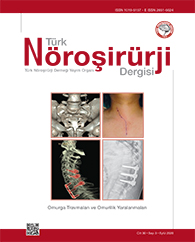Türk Nöroşirürji Dergisi
2020 , Vol 30 , Num 3
Instrumentation in Osteoporotic Vertebra Fractures - Indications and Suggestions for Strengthening the Stabilization System
1Trakya Üniversitesi Tıp Fakültesi, Beyin ve Sinir Cerrahisi Anabilim Dalı, Edirne, Türkiye
Osteoporosis is a metabolic disease that may lead to spinal fractures by decreasing bone quality. It has started to be seen more
and more frequently with the increasing elderly population. Although most osteoporotic vertebral fractures show spontaneous
healing, sometimes progressive collapse, kyphotic deformity and neural compression due to spinal canal or intervertebral foramen
narrowing can be seen. Surgical treatment options are minimal invasive procedures such as vertebroplasty and instrumented
stabilization in some cases. In most cases without deformity or neural compression, percutaneous cement support to the vertebral
body (vertebroplasty/kyphoplasty) is sufficient, while in some cases decompression and instrumented stabilization are required. There are many factors to be considered during surgical indication determination and technique selection. Patient age, gender,
comorbidities, weight, body structure, severity of osteoporosis, fracture localization, degree of collapse and angle, balance of
the spine in sagittal and coronal planes, canal and foramen stenosis, pain severity, neurological deficit, the patient"s degree of
activity and expectation from surgery, and the surgeon"s experience and available technical means are the main ones. The risk of
failure of instrumental surgery is high due to reasons such as increased morbidity rates due to the advanced age of osteoporotic
patients, mechanical insufficiency of the bone, and difficulty in fusion. Therefore, instrumentation should only be considered in
patients with absolute indications. There are many measures that can be applied to prevent failure of the instrumentation system,
and sometimes all of them need to be implemented. These measures are pharmacological treatment for osteoporosis, increasing
the levels of fixation to distribute the load, using a sublaminar wire or hook, optimizing the screw application technique, changing
the screw design, applying cement-supported screws, and supporting the anterior column. Fusion should be accelerated by good
bone grafting. Despite all these measures, it should be kept in mind that spinal instrumentation in a patient with osteoporosis may
fail and revision surgery may be required.
Anahtar Kelimeler :
Osteoporosis, Vertebral fracture, Instrumentation

